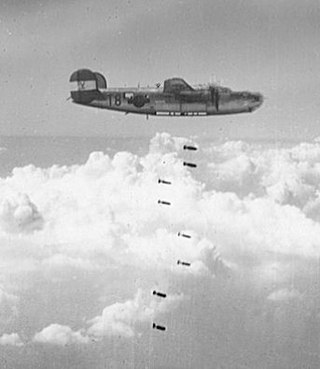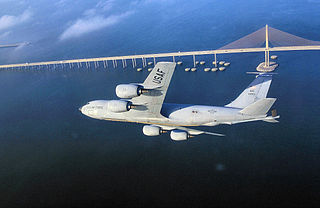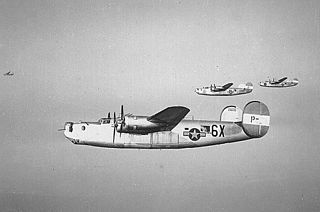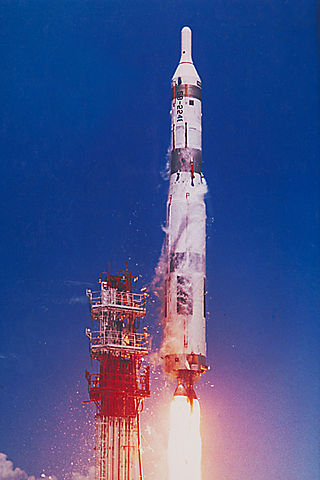
Royal Air Force North Pickenham or more simply RAF North Pickenham is a former Royal Air Force station located 3 miles (4.8 km) East of Swaffham, Norfolk, England.

Royal Air Force Station Harrington or more simply RAF Harrington is a former Royal Air Force station in England about 5.6 miles (9.0 km) west of Kettering in Northamptonshire south of the village of Harrington off the A14 road. During the early Cold War, it was a Thor missile site, designed to deliver atomic warheads to the Soviet Union. The nuclear missile site is now protected as a Grade II listed building as an example of Cold War architecture.

The 490th Bombardment Group is a former United States Army Air Forces unit. The group was activated in October 1943. After training in the United States, it deployed to the European Theater of Operations and participated in the strategic bombing campaign against Germany from 31 May 1944 to 20 April 1945, losing 22 aircraft while flying more than 5,000 sorties. Following V-E Day, the group returned to the United States, where it was inactivated in November 1945.

The 491st Bombardment Group is a former United States Army Air Forces unit. It was activated in October 1943 as a heavy bomber unit, drawing its cadre from the former 17th Antisubmarine Squadron. After training in the United States, the group deployed to the European Theater of Operations, where it participated in the strategic bombing campaign against Germany, earning a Distinguished Unit Citation in an attack against Misburg. The group flew 187 combat missions. Following V-E Day, the group returned to the United States and was inactivated at McChord Field, Washington in September 1945.

The 91st Air Refueling Squadron is part of the 6th Air Mobility Wing at MacDill Air Force Base, Florida. It operates the Boeing KC-135R Stratotanker aircraft conducting air refueling missions.

The 906th Air Refueling Squadron is an active United States Air Force unit. It is an active associate squadron and part of the 375th Air Mobility Wing at Scott Air Force Base, Illinois.

The 855th Bombardment Squadron is an inactive United States Air Force unit. The squadron was first activated as the 522d Bombardment Squadron at Lantana Airport, Florida, in October 1942, when it assumed the personnel and equipment of a National Guard unit engaged in antisubmarine warfare over the Atlantic. The squadron continued antisubmarine patrols as the 17th Antisubmarine Squadron until the summer of 1943, when its mission was transferred to the Navy.

The 859th Special Operations Squadron is a reserve unit of the United States Air Force. It was first activated in October 1942 as the 517th Bombardment Squadron, when the Army Air Forces replaced National Guard observation units that had been mobilized and were performing antisubmarine patrols off the Atlantic coastline. A month after its activation, the squadron was redesignated the 12th Antisubmarine Squadron. In August 1943, the Army Air forces began turning the antisubmarine patrol mission over to the Navy and the squadron moved to California, where, as the 859th Bombardment Squadron, it formed the cadre for the 492d Bombardment Group.

The 492nd Special Operations Wing is a United States Air Forces unit stationed at Hurlburt Field, Florida. It was activated in May 2017 to replace the Air Force Special Operations Air Warfare Center.

The 856th Bombardment Squadron was a United States Army Air Forces unit. it was first activated in October 1943 as one of the original Consolidated B-24 Liberator squadrons of the 492d Bombardment Group. After deploying to England, the 492d entered the strategic bombing campaign against Germany, but in three months of combat, the 492d Group suffered the most severe losses of an Eighth Air Force bomber group. The 492d Group was withdrawn from combat in August 1944, and the 856th moved on paper to replace the 36th Bombardment Squadron, which was engaged in Operation Carpetbagger, dropping agents and supplies behind German lines, primarily in France. As American forces advanced in France, this special operations mission diminished. The squadron briefly transported fuel to mechanized units in France, then returned to special operations in Scandinavia and Germany under the operational control of Eighth Air Force until the end of hostilities in Europe. It returned to the United States for conversion to Boeing B-29 Superfortresses, but was inactivated in October 1945.

The 850th Strategic Missile Squadron is an inactive United States Air Force unit. It was last assigned to the 44th Strategic Missile Wing at Ellsworth Air Force Base, South Dakota, where it was inactivated on 25 March 1965. The squadron was first activated in 1943 as the 850th Bombardment Squadron. After training in the United States, it deployed to the European Theater of Operations and participated in the strategic bombing campaign against Germany. Following V-E Day, the squadron returned to the United States, where it was inactivated in November 1945.

The 848th Strategic Missile Squadron is an inactive United States Air Force unit. It was last assigned to the 703d Strategic Missile Wing at Lowry Air Force Base, Colorado, where it was inactivated on 1 July 1961. The squadron was first activated in 1943 as the 848th Bombardment Squadron during World War II. After training in the United States, it deployed to the European Theater of Operations and participated in the strategic bombing campaign against Germany. Following V-E Day, the squadron returned to the United States, where it was inactivated in November 1945. It was activated as an intercontinental ballistic missile squadron in 1960.

The 849th Strategic Missile Squadron is an inactive United States Air Force unit. It was last assigned to the 703d Strategic Missile Wing at Lowry Air Force Base, Colorado, where it was inactivated on 1 July 1961 and its assets transferred to another squadron that was simultaneously activated.

The 852nd Bombardment Squadron is a former United States Army Air Forces unit. It was activated in October 1943 as a heavy bomber unit. After training in the United States, the squadron deployed to the European Theater of Operations, where it participated in the strategic bombing campaign against Germany, earning a Distinguished Unit Citation in an attack against Misburg. Following V-E Day, the squadron returned to the United States and was inactivated at McChord Field, Washington in September 1945.

The 853rd Bombardment Squadron was a United States Army Air Forces unit. It was activated in October 1943 as a heavy bomber unit. After training in the United States, the squadron deployed to Great Britain, where it participated in the strategic bombing campaign against Germany, earning a Distinguished Unit Citation in an attack against Misburg. Following V-E Day, the squadron returned to the United States and was inactivated at McChord Field, Washington in September 1945.

The 854th Bombardment Squadron is a former United States Army Air Forces unit. It was activated in October 1943 as a heavy bomber unit. After training in the United States, the squadron deployed to the European Theater of Operations, where it participated in the strategic bombing campaign against Germany, earning a Distinguished Unit Citation in an attack against Misburg. Following V-E Day, the squadron returned to the United States and was inactivated at McChord Field, Washington in September 1945.

The 784th Bombardment Squadron is the senior predecessor of the 784th Tactical Air Support Training Squadron. It was organized in August 1943 as a heavy bomber unit. After training in the United States with Consolidated B-24 Liberators, the 784th moved to England, where it participated in the strategic bombing campaign against Germany. Following V-E Day, it returned to the United States, where it began training with Boeing B-29 Superfortresses, but was inactivated in October 1945.

The 860th Bombardment Squadron is a former United States Army Air Forces unit that was assigned to the 493d Bombardment Group during World War II. It was part of the last bombardment group to be assigned to Eighth Air Force. It flew combat missions until V-E Day, then returned to the United States for inactivation. In 1985, the squadron was consolidated with the 660th Bombardment Squadron, a Strategic Air Command unit that flew Boeing B-47 Stratojets during the Cold War. Although the two squadrons were consolidated as the 967th Airborne Warning and Control Squadron, they have never been active under that designation.

The 788th Tactical Fighter Squadron is an inactive United States Air Force unit. During World War II, as the 788th Bombardment Squadron, it was assigned to the 467th Bombardment Group as a Consolidated B-24 Liberator squadron in 1943. After training in the United States, it moved to the European Theater of Operations the following year. It saw combat until the surrender of Germany in May 1945, earning a French Croix de Guerre with Palm for its actions contributing to the liberation of France. From May to August 1944, the squadron was detached to the 801st Bombardment Group (Provisional) engaging in Operation Carpetbagger operations. After V-E Day, the squadron returned to the United States and transitioned into the Boeing B-29 Superfortress It was inactivated on 4 August 1946 at Clovis Army Air Field, New Mexico.

The 968th Expeditionary Airborne Air Control Squadron is a provisional unit of the United States Air Force, flying the Boeing E-3G Sentry. Since March 2022, the squadron is stationed at Prince Sultan Air Base, Saudi Arabia. It has been activated twice during the Global War on Terror.





















